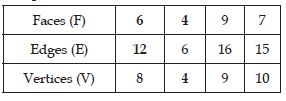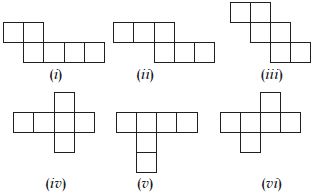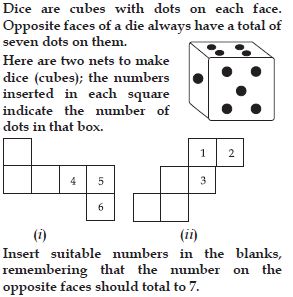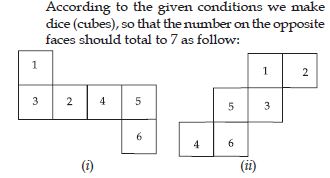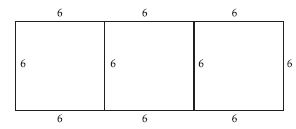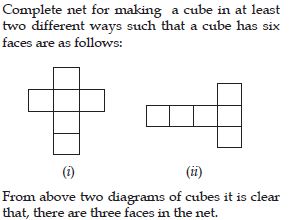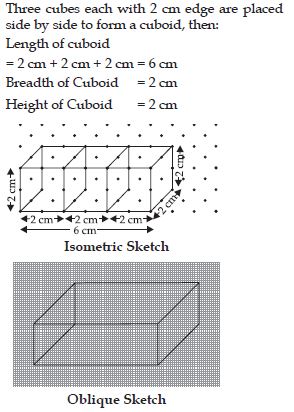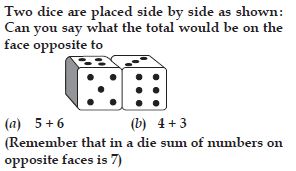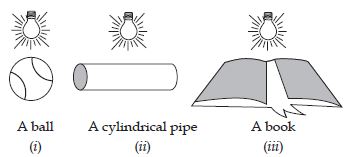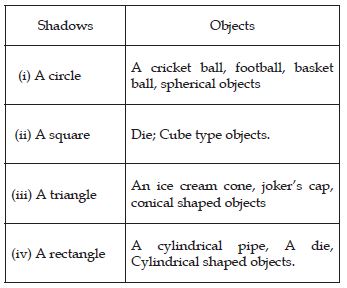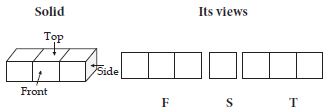Question 1:
Complete the following table:
Answer:
Complete table is as follow:
Question 2:
Here you find four nets (Figure). There are two correct nets among them to make a tetrahedron. See if you can work out which nets will make a tetrahedron.
Answer:
In given figures part (i) and part (iii) are two correct nets for a tetrahedron.
Question 3:
Identify the nets which can be used to make cubes (cut out copies of the nets and try it):
Answer:
Nets in (ii), (iii), (iv) and (vi) form cubes.
Question 4:
Answer:
Question 5:
Can this be a net for a die? Explain your answer.
Answer:
Reason: Because one pair of opposite faces will have 1 and 4 on them whose total is not 7 and another pair of opposite faces will have 3 and 6 on them whose total is also not 7.
Question 6:
Here is an incomplete net for making a cube. Complete it in at least two different ways. Remember that a cube has six faces. How many are there in the net here? (Give two separate diagrams. If you like, you may use a squared sheet for easy manipulation).
Answer:
Question 7:
The dimensions of a cuboid are 5 cm, 3 cm and 2 cm. Draw three different isometric sketches of this cuboid.
Answer:
Dimensions of cuboid are 5 cm, 3 cm and 2 cm. By changing length, breadth and height, we get three different isometric sketches of cuboid are as follow:
Question 8:
Three cubes each with 2 cm edge are placed side by side to form a cuboid. Sketch an oblique or isometric sketch of this cuboid.
Answer:
Question 9:
Try to guess the number of cubes in the following arrangements (Fig.) :
Answer:
Number of cubes in the arrangements are as
follows:
(i) 24 cubes (ii) 8 cubes
(iii) 9 cubes.
Question 10:
Answer:
Numbers on the opposite face:
(a) 5 + 6 is 2 + 1
and (b) 4 + 3 is 3 + 4.
Question 11:
What cross-sections do you get when you give a
(i) vertical cut
(ii) horizontal cut
to the following solids?
(a) A brick
(b) A round apple
(c) A die
(d) A circular pipe
(e) An ice cream cone.
Answer:
When we give a vertical cut then following
cross-sections are obtained:
(a) A brick — Cuboid
(b) A round apple — Circular
(c) A die — Square
(d) A circular pipe — Circular
(e) An ice cream cone — Curved shape
When we give a horizontal cut then following
cross-sections are obtained:
(a) A brick —Cuboid
(b) A round apple —Circular
(c) A die —Cuboid
(d) A circular pipe —Hemispherical
(e) An ice cream cone —Frustrum
Question 12:
A bulb is kept burning just right above the following solids. Name the shape of the shadows obtained in each case. Attempt to give a rough sketch of the shadow. (You may try to experiment first and then answer these questions.)
Answer:
Question 13:
Here are the shadows of some 3-D objects, when seen under the lamp of an overhead projector. Identify the solid(s) that match each shadow. (There may be multiple answers for these !)
Answer:
Shadows of some 3-D objects, when seen under the lamp of an overhead projector.
Question 14:
The cube can cast a shadow in the shape of a rectangle.
- TRUE
- FALSE
Answer:
TRUE
Question 15:
The cube can cast a shadow in the shape of a hexagon.
- TRUE
- FALSE
Answer:
FALSE
Question 16:
For each solid, the three views (1), (2), (3) are given. Identify for each solid the corresponding top, front and side views.
Answer:
(1) Front (2) Side (3) Top
Question 17:
For each solid, the three views (1), (2), (3) are given. Identify for each solid the corresponding top, front and side views.
Answer:
(1) Top (2) Side (3) Front
Question 18:
For each solid, the three views (1), (2), (3) are given. Identify for each solid the corresponding top, front and side views.
Answer:
(1) Side (2) Front (3) Top
Question 19:
For each solid, the three views (1), (2), (3) are given. Identify for each solid the corresponding top, front and side views.
Answer:
(1) Side (2) Top (3) Front


